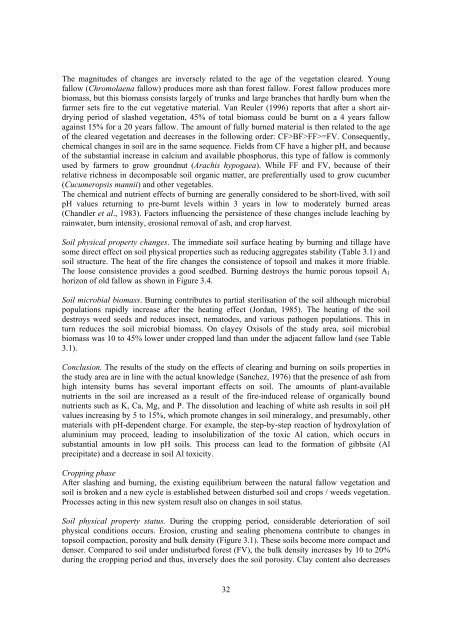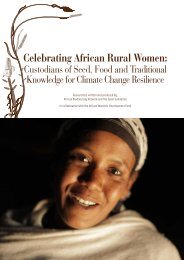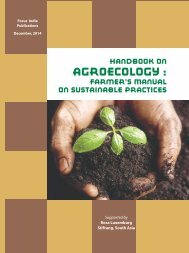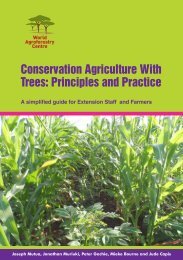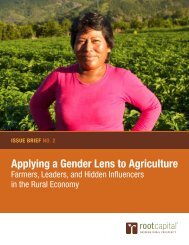1t0SC7l
1t0SC7l
1t0SC7l
Create successful ePaper yourself
Turn your PDF publications into a flip-book with our unique Google optimized e-Paper software.
The magnitudes of changes are inversely related to the age of the vegetation cleared. Young<br />
fallow (Chromolaena fallow) produces more ash than forest fallow. Forest fallow produces more<br />
biomass, but this biomass consists largely of trunks and large branches that hardly burn when the<br />
farmer sets fire to the cut vegetative material. Van Reuler (1996) reports that after a short airdrying<br />
period of slashed vegetation, 45% of total biomass could be burnt on a 4 years fallow<br />
against 15% for a 20 years fallow. The amount of fully burned material is then related to the age<br />
of the cleared vegetation and decreases in the following order: CF>BF>FF>=FV. Consequently,<br />
chemical changes in soil are in the same sequence. Fields from CF have a higher pH, and because<br />
of the substantial increase in calcium and available phosphorus, this type of fallow is commonly<br />
used by farmers to grow groundnut (Arachis hypogaea). While FF and FV, because of their<br />
relative richness in decomposable soil organic matter, are preferentially used to grow cucumber<br />
(Cucumeropsis mannii) and other vegetables.<br />
The chemical and nutrient effects of burning are generally considered to be short-lived, with soil<br />
pH values returning to pre-burnt levels within 3 years in low to moderately burned areas<br />
(Chandler et al., 1983). Factors influencing the persistence of these changes include leaching by<br />
rainwater, burn intensity, erosional removal of ash, and crop harvest.<br />
Soil physical property changes. The immediate soil surface heating by burning and tillage have<br />
some direct effect on soil physical properties such as reducing aggregates stability (Table 3.1) and<br />
soil structure. The heat of the fire changes the consistence of topsoil and makes it more friable.<br />
The loose consistence provides a good seedbed. Burning destroys the humic porous topsoil A 1<br />
horizon of old fallow as shown in Figure 3.4.<br />
Soil microbial biomass. Burning contributes to partial sterilisation of the soil although microbial<br />
populations rapidly increase after the heating effect (Jordan, 1985). The heating of the soil<br />
destroys weed seeds and reduces insect, nematodes, and various pathogen populations. This in<br />
turn reduces the soil microbial biomass. On clayey Oxisols of the study area, soil microbial<br />
biomass was 10 to 45% lower under cropped land than under the adjacent fallow land (see Table<br />
3.1).<br />
Conclusion. The results of the study on the effects of clearing and burning on soils properties in<br />
the study area are in line with the actual knowledge (Sanchez, 1976) that the presence of ash from<br />
high intensity burns has several important effects on soil. The amounts of plant-available<br />
nutrients in the soil are increased as a result of the fire-induced release of organically bound<br />
nutrients such as K, Ca, Mg, and P. The dissolution and leaching of white ash results in soil pH<br />
values increasing by 5 to 15%, which promote changes in soil mineralogy, and presumably, other<br />
materials with pH-dependent charge. For example, the step-by-step reaction of hydroxylation of<br />
aluminium may proceed, leading to insolubilization of the toxic Al cation, which occurs in<br />
substantial amounts in low pH soils. This process can lead to the formation of gibbsite (Al<br />
precipitate) and a decrease in soil Al toxicity.<br />
Cropping phase<br />
After slashing and burning, the existing equilibrium between the natural fallow vegetation and<br />
soil is broken and a new cycle is established between disturbed soil and crops / weeds vegetation.<br />
Processes acting in this new system result also on changes in soil status.<br />
Soil physical property status. During the cropping period, considerable deterioration of soil<br />
physical conditions occurs. Erosion, crusting and sealing phenomena contribute to changes in<br />
topsoil compaction, porosity and bulk density (Figure 3.1). These soils become more compact and<br />
denser. Compared to soil under undisturbed forest (FV), the bulk density increases by 10 to 20%<br />
during the cropping period and thus, inversely does the soil porosity. Clay content also decreases<br />
32


